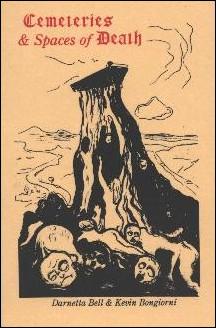
Edited by Darnetta Bell and Kevin Bongiorni
Cemeteries and Spaces of Death
Preface by Jean-Pierre Barricelli
ISBN 1-879378-15-9 (paper)
ix, 147 pages, $15
"The book unites an eclectic collection, illustrating
that since the days of Gilgamesh, death and human expression have grown together
like entwined vines. Man's preoccupation with death becomes lovingly embraced
without acquiring either a too morbid or an overly antiseptic tone... an extremely
valuable depository of expert writings."
~ Chelsea No. 62
From a conference on thanatology held at the University
of California (Riverside), and also at Forest Lawn, comes an unusual collection
of papers:
- Jim Morrison's Grave — Katherine Sutherland
- Jedda and the Ethnography of Death — David Ellison
- Dying to Write: Space and Death in the Poetics of Helene Cixious — Helen Franks
- Danse Macabre: Sources and Cultural Contexts — Michael Stafford
- Stumbling Against the Corpse: Urban Horror and
the Modern Reader in
Frankenstein — Kathleen N. Gurnett - Geraldine as Victim of Patriarchal Repression
in Coleridge's
Christabel — Melissa Bradshaw Vistaunet - Death in the Bedroom: Donne's Love Poetry — Janine Gerzanics
- Demythologizing Death: Wallace Stevens' The Owl and the Sarcophagus — Christina McGinley
- The Aztec Altar of Sacrifice as a Space of Death — William L. Ashline
- The Part That Doesn't Show: Death and Metonymy
in Hemingway's
A Farewell to Arms — Peter A. Duval - Who's Really Dying in Cyberspace? (Street Fighter II) — Roberta Sabbath
Excerpt from "Jim Morrison's Grave"
by Katherine Sutherland
The University College of the Cariboo
The way to Jim Morrison's grave, as everyone knows, is clearly signposted by graffiti, a crude display of youthful irreverence in what may be the most bourgeois graveyard in the Western world, where Jim Morrison rots along with Balzac, Chopin, Moliere, Edith Piaf and Oscar Wilde. I went there in pouring rain with a nurse from Northern California whom I met at a youth hostel. She told a story on the way about a junkie mother who smothered her infant when she rolled over on it in a pharmaceutical fog. Around the grave itself was a motley collection of inebriated youths, hacking joints, gargling Jack Daniels and at one point breaking into a maudlin medley of Doors' tunes. The scene seemed somehow connected to an incident of the previous day, when, in the throes of a severe case of food poisoning, I puked with abandon all over the base of the towering monument at the center of the Place de Republique.
And about here you might expect me to launch into a reading of Jim Morrison's grave which is an ode to post-structural theory, laden with puns about (de)composition. Note the graffiti, for instance: a perfectly post-modern palimpsest of spray paint over spray paint, practically begging for playful deconstruction. Check the tombstone itself, where the bust of Jim Morrison, first grotesquely painted, then finally stolen, sits permanently under erasure. The Doors sell as many albums now as they ever did, constantly reinventing their own mythology with countless bios, videos and a major motion picture, in a signifying system that shifts more often than gears at the Laguna Seca. Jim Morrison himself, dead and not dead, resists closure more than twenty years after his funeral. Representations of the Lizard King do not merely always already open the gap; Jim Morrison IS the gap.
However, in the post-everything period, the world still chokes on its own vomit, the academy still mainlines power and smothers its young, and the young look forward to a future that is more futureless than ever before. And currently the most debilitating obstacle between us and survival in the twenty-first century is the fabrication of a myth of social revolution in the 60's which has left North America morally, intellectually and politically bankrupt. The weird thing about this myth is that it all seems to start and end at Jim Morrison's grave...
Catalog
|About
Us | Links | Order
info